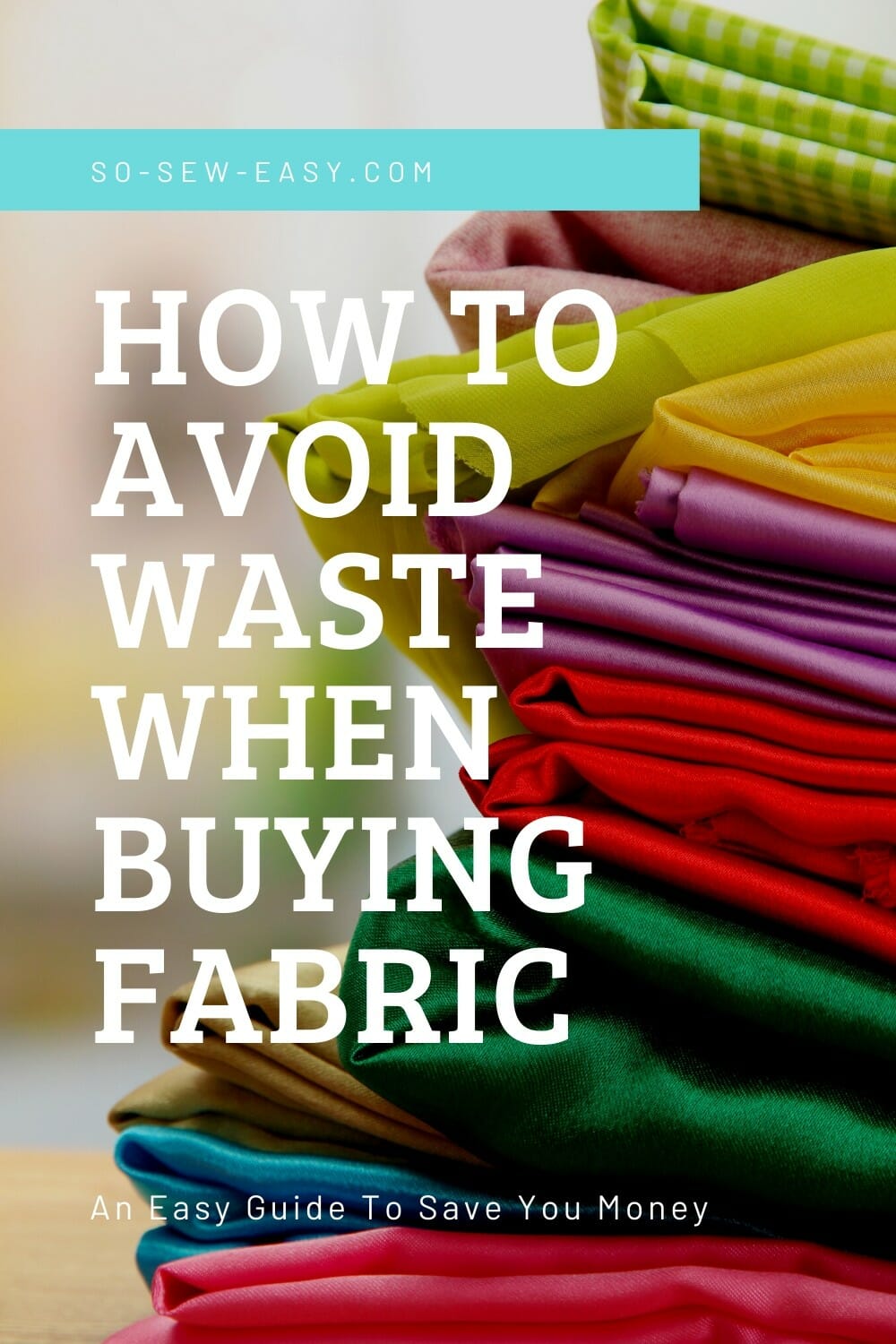 Buying fabric is something we all seamstresses can agree to make us so very happy. The adventure of creating something beautiful and new or simply the desire to possess such fabric moves us to buy and horde it until inspiration suddenly hits us.
Buying fabric is something we all seamstresses can agree to make us so very happy. The adventure of creating something beautiful and new or simply the desire to possess such fabric moves us to buy and horde it until inspiration suddenly hits us.
A question I often get but most of the time ignore is “how much fabric should I buy for this pattern?”.
Phrase the questions differently as a reader, Margo Smith, asked:
“I have been sewing for many years and just wondered if an expert might know why the pattern envelopes always tell you to buy WAY more fabric than needed? Not just a little leftover—but way more. I have so many remnants from sewing and just wondered if you knew why the patterns tell you to buy so much. Thanks for your answer. .”
I typically answer this way. Print the pattern and lay it on a piece of fabric the same width you are planning to buy and work it out for yourself. To some, this might seem like a rude answer, or so I have been told. To others makes sense and that is what they do, I am assuming here since I never hear from them again or maybe because I was rude before, so I guess I will not know…
So why pattern do making companies refuse to give you an exact number?
The reason is that fabric comes in many widths from 24 inches wide rare vicuna fabrics to 59 inches handwoven masterpieces such as the worldwide famous Harris Tweed. Below is a list of the many width fabrics is made:
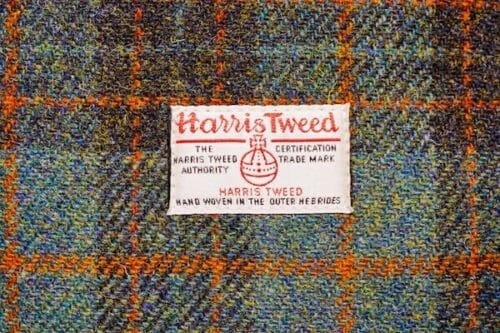

- 36 inches hand-woven silks and hand made batiks, Thailand, Vietnam, Cambodia, Phillipines, Malaysia, Indonesia, Cameroon, and India.
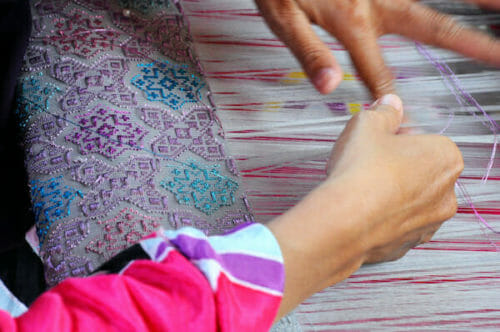

Hand woven silk, Cambodia
- 44-46-48 inches Rayon, cotton quilting (45″) Japan, Korea, USA, Switzerland, and Eastern Europe
- 50-52 inches Linen, Cotton, USA, Ireland, Italy, Lithuania, Latvia
- 52-54 inches mass-produced silk, linen: Italy, China, Korea, Taiwan
- 56-60 inches Jacquards, Denim, Alpaca and Merino wool 58″, linen, ITY knits, polyester in its many forms
- 66 inches Cotton: China, Germany
- 72 inches Cotton: China Germany
- 96 inches Cotton, Polyester, Linen: China, Lithuania, Germany
- 108 – 144 inches: Canvas, Linen, Polyester, China, USA
These are but a few examples of the countries that produce fabrics at such widths.
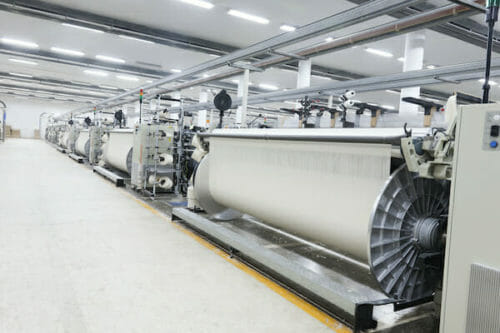

Cotton Weaving Mill
So now you see how difficult it is for pattern making companies tell you exactly how much fabric to buy.
Sadly, the confusion does not end there. We have a few more details to consider:
- your size from 00 to 28 the pattern pieces,
- the direction of the grainline and
- the design of the fabric such as large prints, stripes, or on the bias –all of them needing more fabric to match the design (this is optional of course, and never seen on mass-produced garments such as H&M, GAP, Zara, Forever 21 etc.)
So how to avoid waste when buying fabric?
The first thing you need to understand is what is the grainline and what is the selvage. A good place to start is reading this article I wrote more than four years ago.
For the purpose of this tutorial, I am going to use the latest pattern I shared with you called the Summer Blouse.
This particular blouse calls for a fabric that is 54″ wide and I said you would need two yards and yes you will have leftovers. Here is why I have asked you for a 54″ wide fabric.
- Measure the length of the pattern pieces and add them up.
The first thing you need to consider is the direction of the grainline of the pattern and then measure the pieces from the longest sides.
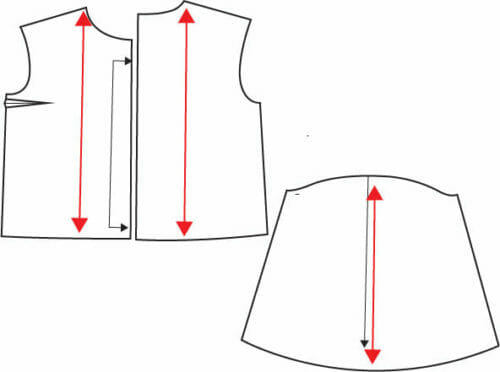

With the Summer Blouse, adding all the lengths of the pieces, I would need 63″ in length. Fabrics online are sold per yard. In small shops, the smallest piece would be 1/4 yard or 1/2 yard. So at a shop, the minimum amount you could buy would be 1 3/4″ for this blouse.
- Measure the width of the pieces and use the widest piece as a buying guide.
The sleeves are the widest and I would need 26″. The pattern does not have a seam allowance so add 1″ for a total of 27“. But there are two sleeves, so double that amount to 54” (we are cutting on the fold remember).
I would need a fabric that is 54″ wide but 56″ would be better in case the fabric needs to be trued. If you do not know how to true or why to do it, please read the article referenced above called Five mistakes to avoid when cutting fabric.
How to lay the fabric if it is 54″ wide?
Both front and back call for the pattern to be placed on the fold while the sleeve is to be placed on a grainline. I have changed the direction of the back to show you no matter how the pattern is traced on the paper you should always follow the markings for the pattern.
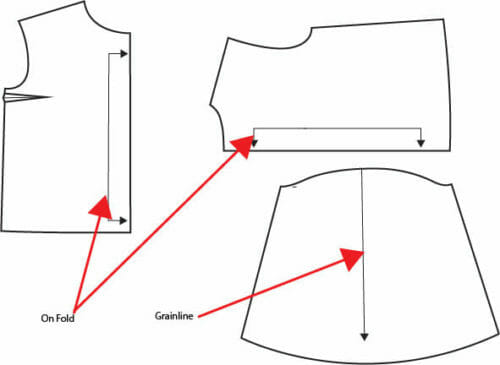

Below it is how to place the fabric.
As you can see you still have some waste on the upper right-hand side and the lower left. 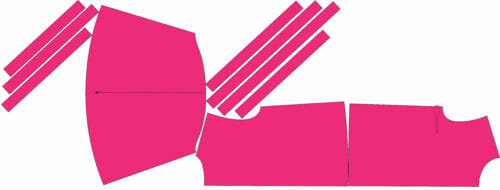

Add some fitted face masks and some round circles to make a fabric covered beaded necklace and this is what you get.
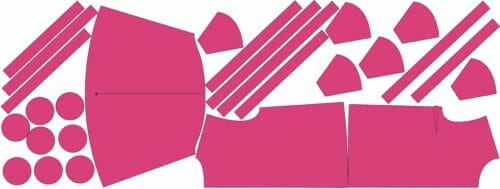

Above is more or less what the factories do when using the fabric. There have special computer programs called Marker Makers or “nesting” programs such as AccuNest. Programs such as this take into account the pattern pieces available, the sizes and the length of the roll to come up with a cutting diagram. These programs can take from 5 to 15 minutes to work out the best way to avoid waste. Needless to say, this is an expensive program running into several thousand but one that pays for itself with time because it helps designers when buying fabric.
Working with a narrower width
Let's say you have a 44″ cotton batiste fabric. The pattern calls for the pieces to be placed on the fold. 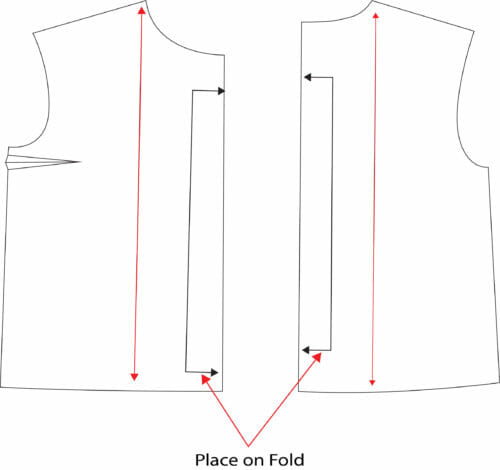

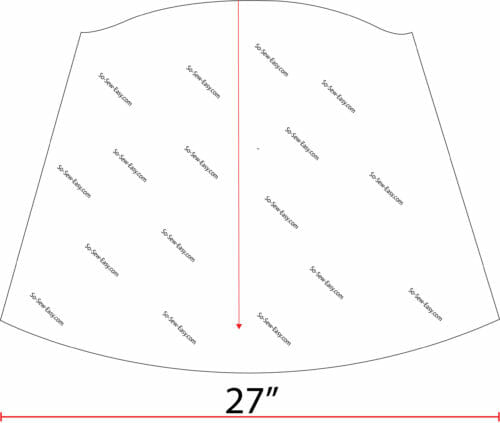

The way to work around this is to trace the other side of the pattern both front and back and trace the other sleeve. You will work with the fabric laid in one layer. Do not get confused below I have placed the rectangle horizontally, the selvage is on the top and bottom so the grainline is running left to right. Measuring all the pieces I will need (86in length) a little less than 2 1/2 yards of fabric but remember that you can only by fabrics that are sold by 1/4 or 1/2 increments.
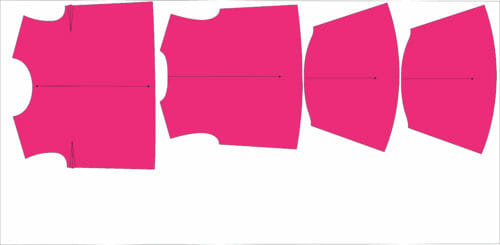

As you can see, there is still some fabric that will be leftover. A better way to utilize all the fabric and avoid waste is shown below. I will be able to make:
One Summer Blouse, 4 fitted face masks, and 6 yards of bias tape. 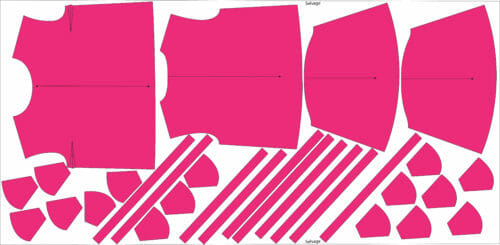

So far I have covered the 54″ of the fold and 44″ single layer. In case you are wondering how much fabric you need, if you retraced the other side of the pattern and want to cut on a single layer, the answer is 1 3/4″ yards.
As you can see there are many more widths of fabric to consider, from 24 to 144 inches or more, add the size, pattern pieces, design of fabric you will know why no one can give you an exact amount and you may end up with some scraps.
Thankfully, on this site, you will find many ideas on how to avoid waste when buying fabric here are some to consider. Next time we will be covering how to choose the right fabrics for your projects.
Here are some small sewing projects that will help you use all those scraps in your stash.
If you have any other tips or tricks about how to avoid waste when buying fabric, please feel free to leave them in the comments below.








Good article, but after 4 decades of sewing, that leftover fabric is a sewer’s joy. It is quilts, lunch bags, Christmas gift bags, and now face masks. I understand that fabric is expensive now. But my leftover fabrc is never waste. It is the next sewing adventure, free of charge.
That is the spirit!
I have one thing to add to your suggestion of laying the pattern out on fabric to figure the yardage needed is that once you have it laid out, take a picture of it so you can remember just how you placed the pieces.
I found that with “double” cut on fold pieces (front and back), if your fabric is wide enough, then mark in from each side of the fabric, half the width of the pattern piece, and fold – and then you have 2 folds across the fabric. after those pieces are cut then re-fold the fabric for the sleeves and/or whatever else needs wider / grain cutting.
Most of the time the cutting layouts make absolutely NO sense at all, and in my 60 years of sewing, stopped consulting them about 50 years ago.
Much of the time, when I buy fabric, it’s because I like it, and don’t necessarily have anything in mind to make with it. If there is a decent amount on the bolt, I’ll buy what’s on it. Sometimes, I’ll just buy the whole bolt!
I took a part-time job at JoAnn Fabrics many years ago so that I wouldn’t spend my “bill money” (from my FT job) on my habit. My dad asked me why I liked it so much, i replied something like “Where else can you touch this much fabric and not have to pay for it?” I’m sure many of my colleagues feel the same way.
Thanks, Mayra for all you do.
It is my pleasure Barb!
Barb, exactly why I had my job @ Joann.
Hi, Mayra, lot of love to u. I manage fabrics for different items making by same fabrics which I am buying from the local wholesale market. These the changes for me lot of things learn from u.(smile).thanks.kiss.
Extra fabric comes in handy to make summer tops for my youngest granddaughter, as well as doll clothes for several granddaughters 18″ dolls. I also make small mug rugs, cord keepers, face masks or whatever else I can find. Quick crafts for home use or gifts. Be creative!
You’re first response was short and sweet. And made perfect sense. However, for a relatively new sewer, this was very informative. I would add, that if you have a good local shop, they will often help with this. Also, many commercial patterns offer measurements and layouts for different widths of fabric, including yardage and layouts for 1-way designs. Thank you!!
Thanks for your promised article on figuring yardages. Easy to understand and very informative. I’m anxious to make the Summer Blouse as soon as I can find suitable weight fabric.
My Pleasure Karen, as you can see you can use 44″ wide cotton but you need to trace either on the fabric or on paper the other side of the pattern. IF you have any other question do not hesitate to reach out. Kind Regards,
It is good to have some extra fabric in case you need to re-cut a piece. You can’t count on buying more fabric that matches.
If you are slim and making a top, you can often get the front and back out of one length of fabric by folding the selvedge edges in to meet in the center. I know I can almost always get a long sleeved tee out of 1.5 yards of knit fabric, or a little less.
Excellent article. I love having a of bit extra fabric for so many reasons. I may want to lengthen a hem, add more seam allowance, change a neckline, fussy-cut a print, widen the waistline, do a full bust adjustment (patterns are usually for B cup), or simply to have some in case you cut a smaller piece incorrectly. If it is expensive fabric, make a beautiful scarf – if it’s a print and you must piece it, no one will see the seams anyway.
The patterns with which I am familiar give yardage according to fabric width. If the chosen fabric’s width is not noted on the envelope, then a conversion chart, saved on a phone or a laminated card carried in a person’s wallet, would be useful.
It’s sad that many people these days are so quick to take offence when none is meant. I would have been quite happy with your response about working it out for myself. But thank you for taking the time to write this post.
😉
Regarding buying fabric, if you are a short person and are making a skirt or pants you can probably subtract at least 1/4 to 1/2 yard from the measurment.
The opposite can also be true. My daughters are both fairly tall and, when making their prom dresses from commercial patterns I had to purchase extra fabric to ensure I had enough length. I actually ended up putting a false hem in the elder daughter’s dress as I had not fully anticipated the need for extra length. The suggested fabric guidelines were for standard fit and the design was obviously for people shorter than 5’8″.
Amazingly enough, the “average” woman in the US is STILL 5’3″ …
Actually, I’m surprised, because people seem to be getting taller with each generation, and this was the average in the 50s and 60s when I was still a child.
FYI, the average American male is still 5’9″.
With regard to Barbara – who is 5’3″, (posted her comment on 4/17/20 at 3:29p). Who knows what height the patterns are made for anymore. One would think that with the above information, that you are the “model” they use.
I am 5′ 3″ tall. A lot of the patterns skirts are mid calf which make me look as wide as I am tall. Many of the pictures make the skirt look calf length, if you are 5’8″.
I know to take any where from 6 ” or as much as 18″ off the fabric order.